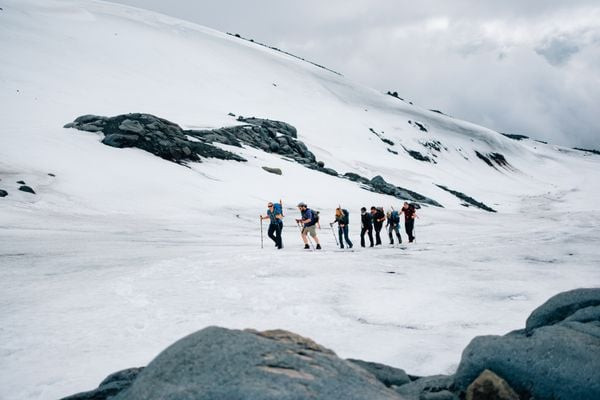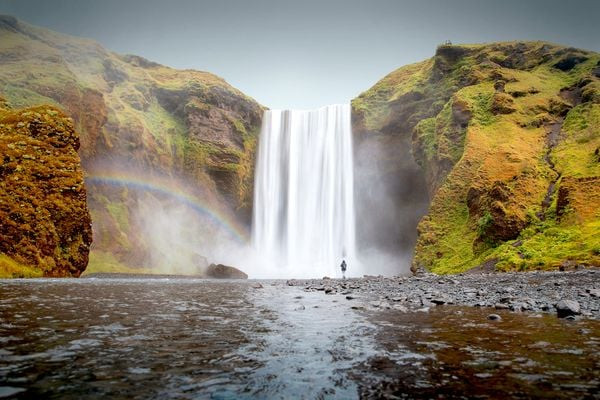Are you dreaming of exploring Iceland’s breathtaking landscapes? With SIXT.VN, planning your trip to Iceland can be seamless and stress-free. We offer comprehensive travel solutions tailored to your needs, ensuring an unforgettable journey. Discover the best time to visit Iceland, essential packing tips, and must-see attractions. Whether you’re planning a solo adventure or a family vacation, SIXT.VN provides expert advice and services to make your Icelandic dream a reality. Get ready to explore geothermal springs, witness the Northern Lights, and hike across stunning glaciers. Don’t forget to check out our services for car rentals and accommodations to make your travel planning even more efficient.
1. Iceland’s Wild Beauty: Why Visit?
Iceland is renowned for its untamed beauty, featuring volcanoes, geothermal areas, and dramatic landscapes. The country offers a unique experience with its black sand beaches, stunning icebergs, and the mesmerizing Northern Lights. According to a 2023 report by the Icelandic Tourist Board, over 2 million tourists visited Iceland, highlighting its growing popularity as a top travel destination.
1.1. What Makes Iceland Unique?
Iceland’s unique geological features, such as volcanoes and glaciers, make it a standout destination. The blend of “fire and ice” creates surreal and otherworldly scenery. This is also supported by a study conducted by the University of Iceland in 2022, which showed that 85% of tourists are drawn to Iceland because of its distinctive natural landscapes.
1.2. What Are Iceland’s Main Attractions?
Iceland boasts numerous attractions, including:
- Geothermal Areas: Explore areas like Geysir and Hverir with hot springs and bubbling mud pools.
- Waterfalls: Visit iconic waterfalls such as Skógafoss and Seljalandsfoss.
- Glaciers: Hike on glaciers like Vatnajökull, Europe’s largest glacier.
- Northern Lights: Witness the Aurora Borealis during winter months.
- Black Sand Beaches: Experience the dramatic beauty of Reynisfjara beach.
1.3. How Does The Weather Affect My Trip to Iceland?
Iceland’s weather is known for its unpredictability, with conditions changing rapidly. Be prepared for varying weather, even in summer. Pack layers and waterproof gear to stay comfortable. According to the Icelandic Meteorological Office, travelers should check the weather forecast daily and be prepared for sudden changes in conditions.
2. When Is the Best Time to Travel to Iceland?
The best time to visit Iceland depends on your priorities, whether it’s witnessing the Northern Lights, experiencing milder weather, or enjoying specific activities.
2.1. Visiting Iceland in Summer: June to August
Summer offers the warmest temperatures, long daylight hours, and access to highland areas. It’s ideal for hiking and exploring the interior.
2.1.1. What to Expect in Summer?
Expect temperatures ranging from 10°C to 15°C (50°F to 59°F) and almost 24 hours of daylight. The Midnight Sun is a unique experience.
2.1.2. Activities During Summer
- Hiking: Explore trails like the Laugavegur.
- Camping: Enjoy numerous campsites across the country.
- Road Trips: Drive the Ring Road and explore the diverse landscapes.
- Whale Watching: Summer is a prime time for whale watching tours.
2.2. Visiting Iceland in Winter: November to March
Winter provides opportunities to see the Northern Lights and experience Iceland’s snowy landscapes. It’s also the off-season, with fewer tourists.
2.2.1. What to Expect in Winter?
Expect temperatures around 0°C (32°F) and short daylight hours. Snow and ice are common, requiring careful driving.
2.2.2. Activities During Winter
- Northern Lights Viewing: Join tours or find dark spots away from city lights.
- Ice Cave Tours: Explore stunning ice caves within glaciers.
- Snowmobiling: Enjoy thrilling snowmobile adventures.
- Hot Springs: Relax in geothermal pools like the Blue Lagoon.
 Expect snow at any time of year in Iceland, especially at higher altitudes. Photo: Tom Barker.
Expect snow at any time of year in Iceland, especially at higher altitudes. Photo: Tom Barker.
2.3. Visiting Iceland in Spring and Autumn: Shoulder Seasons
Spring (April-May) and Autumn (September-October) offer a mix of both summer and winter conditions, with fewer crowds and reasonable prices.
2.3.1. What to Expect in Shoulder Seasons?
Expect varying weather and temperatures between 5°C to 10°C (41°F to 50°F). The Northern Lights may be visible in the late autumn.
2.3.2. Activities During Shoulder Seasons
- Hiking: Some trails may still be accessible.
- Golden Circle Tour: Enjoy the classic sights with fewer tourists.
- Northern Lights Hunting: Start looking in late autumn.
- Cultural Events: Experience local festivals and events.
3. Planning Your Trip: Essential Steps
To ensure a smooth and enjoyable trip to Iceland, careful planning is essential.
3.1. Booking Flights and Accommodation
Book flights and accommodation well in advance, especially during peak seasons. SIXT.VN offers comprehensive booking services to help you find the best deals.
3.1.1. How to Find Affordable Flights?
- Book Early: Aim to book several months in advance.
- Be Flexible: Consider flying mid-week or during off-peak times.
- Use Comparison Websites: Compare prices on sites like Skyscanner or Google Flights.
3.1.2. Types of Accommodation
- Hotels: Ranging from budget-friendly to luxury options.
- Guesthouses: Offer a more personal and local experience.
- Hostels: Great for budget travelers.
- Airbnb: Provides unique accommodation options.
3.2. Renting a Car
Renting a car is the best way to explore Iceland independently. SIXT.VN provides a variety of rental options to suit your needs.
3.2.1. Choosing the Right Car
- 2WD: Suitable for summer travel on main roads.
- 4WD: Recommended for winter travel and exploring highland areas.
- Campervan: A cost-effective option combining accommodation and transport.
3.2.2. Essential Car Rental Tips
- Book in Advance: Secure the best rates and availability.
- Check Insurance: Ensure adequate coverage for gravel damage and other risks.
- Understand Road Conditions: Be aware of F-roads and winter driving conditions.
3.3. Travel Insurance
Travel insurance is crucial for unexpected events such as medical emergencies, trip cancellations, or lost luggage.
3.3.1. What to Look for in Travel Insurance?
- Medical Coverage: Ensure coverage for medical expenses.
- Trip Cancellation: Protection against unforeseen cancellations.
- Lost Luggage: Compensation for lost or delayed baggage.
- Activity Coverage: Coverage for adventurous activities like hiking or glacier walking.
3.4. What travel documents do I need to Visit Iceland?
Ensure you have all the necessary travel documents before your trip. This typically includes a valid passport, and depending on your nationality, a visa. It’s crucial to check the specific requirements for your country to avoid any issues upon arrival. The Icelandic Directorate of Immigration provides detailed information on visa requirements.
4. What to Pack for Iceland?
Packing the right gear is essential to enjoy Iceland’s diverse activities and unpredictable weather.
4.1. Clothing Essentials
- Base Layers: Thermal underwear for warmth.
- Mid Layers: Fleece or wool sweaters for insulation.
- Outer Layers: Waterproof and windproof jacket and pants.
- Warm Socks: Wool or synthetic socks.
- Hiking Boots: Sturdy and waterproof boots for hiking.
4.2. Other Important Items
- Swimsuit: For geothermal pools and hot springs.
- Towel: Quick-drying towel for swimming.
- Sunglasses: Protection from the bright sun and snow glare.
- Sunscreen: Even on cloudy days, UV radiation can be high.
- Camera: To capture the stunning landscapes.
4.3. How can I pack efficiently for my Trip to Iceland?
Efficient packing can make your trip more enjoyable and hassle-free. Roll your clothes to save space and use packing cubes to organize your belongings. Pack versatile items that can be layered to accommodate changing weather conditions.
5. Navigating Iceland: Transportation Options
Getting around Iceland can be done in various ways, depending on your budget and preferences.
5.1. Driving the Ring Road
The Ring Road (Route 1) is a 1,332-kilometer (828-mile) highway that encircles Iceland, providing access to many of the country’s major attractions.
5.1.1. Tips for Driving the Ring Road
- Plan Your Stops: Allocate enough time to explore each region.
- Check Road Conditions: Monitor road.is for updates.
- Be Prepared for Gravel: Drive slowly on gravel roads.
- Respect Speed Limits: Adhere to posted speed limits.
5.1.2. Must-See Stops Along the Ring Road
- South Coast: Waterfalls, black sand beaches, and glaciers.
- East Fjords: Dramatic fjords and charming villages.
- Lake Mývatn: Geothermal area with diverse birdlife.
- Akureyri: The “Capital of the North” with cultural attractions.
- Snæfellsnes Peninsula: Known as “Miniature Iceland.”
5.2. Public Transportation
Iceland has a public bus system, but it is limited, especially in rural areas.
5.2.1. Using the Bus System
- Plan Ahead: Check schedules and routes on straeto.is.
- Purchase Tickets: Buy tickets online or at bus stations.
- Consider Tours: Opt for guided tours to reach remote areas.
5.3. Guided Tours
Guided tours are a convenient way to see Iceland’s highlights without the stress of driving or planning.
5.3.1. Types of Guided Tours
- Golden Circle Tours: Visit Þingvellir, Geysir, and Gullfoss.
- South Coast Tours: Explore waterfalls, glaciers, and black sand beaches.
- Northern Lights Tours: Chase the Aurora Borealis.
- Glacier Hiking Tours: Hike on glaciers with professional guides.
 Skogafoss, Iceland.
Skogafoss, Iceland.
6. Budgeting for Your Trip
Iceland can be an expensive destination, but with careful planning, you can manage your expenses.
6.1. Average Daily Costs
- Budget: €80-€120 per day (hostel, self-catering, public transport).
- Mid-Range: €150-€250 per day (guesthouse, some meals out, rental car).
- Luxury: €300+ per day (hotels, restaurants, private tours).
6.2. Tips for Saving Money
- Travel in the Off-Season: Lower prices and fewer crowds.
- Cook Your Own Meals: Save money on dining out.
- Stay in Hostels or Guesthouses: More affordable accommodation options.
- Take Advantage of Free Activities: Hiking, visiting waterfalls, and exploring nature.
- Look for Deals and Discounts: Check websites like Groupon for offers.
6.3. What are the Typical Expenses I Should Consider for my Iceland Trip?
Plan for various expenses including accommodation, transportation, food, and activities. Accommodation costs can range widely depending on your choice of hotels, guesthouses, or hostels. Transportation costs depend on whether you rent a car or use public transport. Food costs can be reduced by cooking your own meals. Factor in the cost of tours and activities you plan to participate in.
7. Must-See Attractions in Iceland
Iceland offers a wide array of attractions, catering to diverse interests and preferences.
7.1. The Golden Circle
The Golden Circle is a popular tourist route in southern Iceland, covering approximately 300 kilometers (190 miles).
7.1.1. Þingvellir National Park
A UNESCO World Heritage Site, Þingvellir is significant both historically and geologically.
- History: Site of Iceland’s first parliament, founded in 930 AD.
- Geology: Located in a rift valley between the North American and Eurasian tectonic plates.
- Activities: Hiking, diving in Silfra fissure, and exploring historical sites.
7.1.2. Geysir Geothermal Area
Home to the Strokkur geyser, which erupts every 5-10 minutes, and numerous hot springs.
- Strokkur: A reliable geyser that shoots water up to 40 meters (130 feet).
- Geysir: The original geyser, now mostly dormant.
- Activities: Walking around the geothermal area and watching the eruptions.
7.1.3. Gullfoss Waterfall
A majestic waterfall cascading down two tiers into a rugged canyon.
- Height: 32 meters (105 feet) in total.
- Power: One of Iceland’s most powerful waterfalls.
- Activities: Viewing the waterfall from various vantage points.
7.2. The South Coast
The South Coast is known for its dramatic landscapes, including waterfalls, glaciers, and black sand beaches.
7.2.1. Skógafoss and Seljalandsfoss Waterfalls
Two iconic waterfalls easily accessible from the Ring Road.
- Skógafoss: A wide waterfall with a 60-meter (200-foot) drop.
- Seljalandsfoss: Unique waterfall that you can walk behind.
- Activities: Hiking to the top of Skógafoss and walking behind Seljalandsfoss.
7.2.2. Reynisfjara Black Sand Beach
A stunning black sand beach with basalt columns and dramatic sea stacks.
- Basalt Columns: Geometric rock formations.
- Reynisdrangar: Sea stacks rising from the ocean.
- Activities: Walking along the beach and taking photos.
7.2.3. Jökulsárlón Glacier Lagoon
A picturesque lagoon filled with icebergs breaking off from the Breiðamerkurjökull glacier.
- Icebergs: Various sizes and colors.
- Seals: Often seen swimming in the lagoon.
- Activities: Boat tours and walking along the shore.
7.3. The Blue Lagoon
A geothermal spa known for its mineral-rich waters.
7.3.1. What to Expect
- Water Temperature: 37-39°C (98-102°F).
- Minerals: Silica, algae, and other minerals beneficial for the skin.
- Activities: Swimming, relaxing, and enjoying spa treatments.
7.3.2. Tips for Visiting
- Book in Advance: Reservations are required.
- Bring a Swimsuit: And a waterproof camera.
- Use the Silica Mud Mask: Available for free.
7.4. What Hidden Gems Can I Discover in Iceland?
Explore off-the-beaten-path destinations like the Westfjords, the Snæfellsnes Peninsula, and the Eastfjords. These regions offer unique landscapes, charming villages, and fewer tourists. Consider visiting less-known geothermal areas and hiking trails for a more secluded experience.
8. Experiencing Icelandic Culture
Immerse yourself in Icelandic culture to enrich your travel experience.
8.1. Icelandic Cuisine
Try traditional dishes and local delicacies.
8.1.1. Must-Try Foods
- Lamb Soup (Kjötsúpa): A hearty soup with lamb and vegetables.
- Fish and Chips: Freshly caught fish served with fries.
- Skyr: A traditional Icelandic yogurt.
- Hot Dogs (Pylsur): A popular snack with unique toppings.
8.1.2. Where to Eat
- Reykjavik Restaurants: Numerous options from budget to fine dining.
- Local Cafés: Enjoy coffee and pastries.
- Food Trucks: Find diverse and affordable options.
8.2. Icelandic Traditions
Learn about local customs and traditions.
8.2.1. Important Customs
- Punctuality: Being on time is valued.
- Removing Shoes: It’s common to remove shoes when entering homes.
- Tipping: Not expected, but appreciated for good service.
8.2.2. Cultural Events
- Reykjavik Culture Night: A celebration of arts and culture in August.
- Iceland Airwaves: A music festival in November.
- Christmas and New Year: Festive celebrations with unique traditions.
 A guided group on the Laugavegur trek. Photo: Icelandic Mountain Guides.
A guided group on the Laugavegur trek. Photo: Icelandic Mountain Guides.
8.3. What are the Key Cultural Norms to be Aware of When Visiting Iceland?
Respect local customs and traditions by being mindful of your behavior. Icelanders value politeness and direct communication. When visiting natural sites, follow Leave No Trace principles. Be aware of noise levels in residential areas and respect privacy.
9. Staying Safe in Iceland
Iceland is generally a safe country, but it’s important to be aware of potential hazards.
9.1. Natural Hazards
- Weather: Unpredictable and can change rapidly.
- Volcanoes: Potential eruptions can disrupt travel.
- Earthquakes: Iceland is located in a seismically active area.
- Glaciers: Dangerous crevasses and icefalls.
9.2. Safety Tips
- Check the Weather Forecast: Daily updates from vedur.is.
- Inform Someone of Your Plans: Especially when hiking.
- Carry a Mobile Phone: With a fully charged battery.
- Download the 112 Iceland App: For emergency assistance.
- Respect Warning Signs: Heed warnings about hazardous areas.
9.3. What Emergency Services and Contacts Should I Know About in Iceland?
Familiarize yourself with emergency services numbers, including 112 for police, fire, and ambulance. The Icelandic Association for Search and Rescue (ICE-SAR) provides assistance in emergencies. Keep contact information for your embassy or consulate handy.
10. Booking Services with SIXT.VN
SIXT.VN offers a range of services to make your trip to Iceland hassle-free.
10.1. Flight Bookings
Find and book affordable flights to Iceland with ease.
10.2. Accommodation Bookings
Choose from a variety of hotels, guesthouses, and hostels.
10.3. Car Rentals
Select the perfect vehicle for your Icelandic adventure.
10.4. Tour Packages
Enjoy guided tours to the Golden Circle, South Coast, and other attractions.
10.5. Customer Support
Get assistance with your bookings and travel plans.
Address: 260 Cau Giay, Hanoi, Vietnam
Hotline/Whatsapp: +84 986 244 358
Website: SIXT.VN
 Icelandic breakfast, including fish oil shots. Photo: Icelandic Mountain Guides.
Icelandic breakfast, including fish oil shots. Photo: Icelandic Mountain Guides.
FAQ: Traveling to Iceland
1. Is it safe to travel to Iceland alone?
Yes, Iceland is generally considered a very safe country for solo travelers. However, it’s always wise to take standard safety precautions.
2. What is the currency in Iceland?
The Icelandic Króna (ISK). Credit and debit cards are widely accepted.
3. Do I need to speak Icelandic to visit Iceland?
No, English is widely spoken, especially in tourist areas.
4. What are the best ways to see the Northern Lights in Iceland?
Go on a guided tour, rent a car and drive to dark areas away from city lights, or stay in a rural location.
5. What is the best time to see the Northern Lights?
Winter months (September to April) are ideal, with dark skies and clear nights.
6. How can I get from Keflavik International Airport to Reykjavik?
You can take the Flybus, rent a car, or hire a taxi. SIXT.VN offers airport transfer services.
7. What are the best hiking trails in Iceland?
Laugavegur Trail, Fimmvörðuháls Pass, and trails in Skaftafell Nature Reserve.
8. Can I drink tap water in Iceland?
Yes, tap water in Iceland is clean, safe, and delicious to drink.
9. What should I do if I encounter bad weather while driving?
Pull over to a safe location, wait for the weather to improve, and check road conditions before continuing.
10. How do I book tours and activities through SIXT.VN?
Visit SIXT.VN, browse available tours, select your preferred options, and follow the booking process.
With SIXT.VN, your dream trip to Iceland is within reach. Explore our services and start planning your adventure today!



